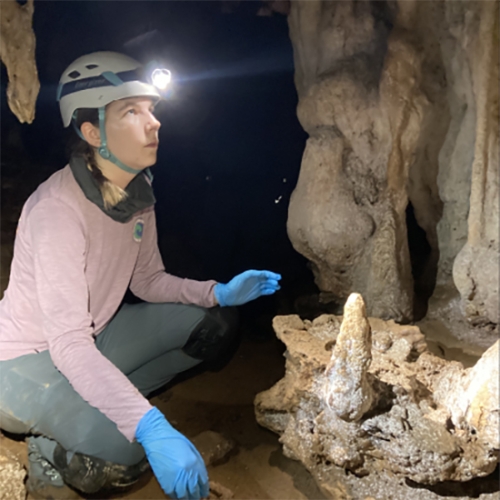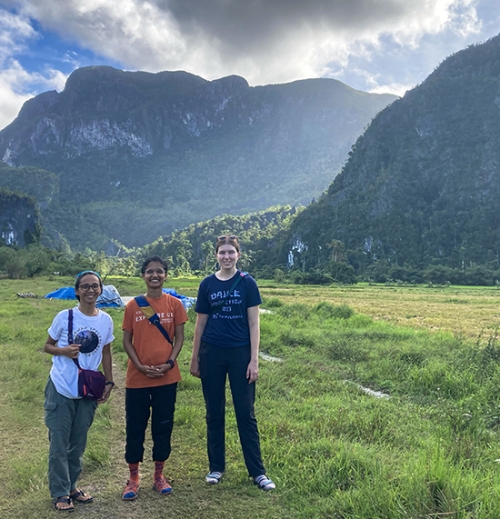Mira Hart ’26 pursued her passion for climate research through international fieldwork in the Philippines—crawling through caves, collecting stalagmites, and uncovering ancient data that could help predict Earth’s future.
Mira Hart enjoyed science in high school and assumed she would major in chemistry, although as a self-described “outdoorsy person,” she had a hard time imagining herself working with molecules in a lab as a career. But when she joined the Geology Club in her first semester at Occidental, the Seattle resident found her passion—a field of study that combined her existing love for the outdoors and chemistry with her newfound interests.

“I quickly learned that I was way more interested in the questions geology poses and that I could use chemistry to find the answers to these questions,” says Hart, who recently traveled to the Philippines with Assistant Professor of Geology Natasha Sekhon. There they worked with local researchers and the caving community to install water collectors at three cave sites, gather data on stalagmite formation, and collect stalagmites for further analysis.
The hands-on experience taught Hart how to conduct cave monitoring field work, an integral part of reconstructing climate change data, and she hopes her research will produce a more thorough understanding of ancient climate change as well as clues to help predict Earth’s climate future.
Through Sekhon’s examinations of infiltrated water and stalagmite growth, which she has been studying in the Philippines since 2022, she is able to reconstruct periods of previous climate change as far back as 140,000 years ago. “Cave formations such as stalagmites are valuable time capsules that store clues to ancient water climates, going back hundreds of thousands of years,” she says.
Hart is following in Sekhon’s footsteps, gathering data about changes in the strength of the Philippines’ monsoon seasons across geological eras. Using two stalagmite samples collected from the Puerto Princesa Subterranean River National Park cave system, Hart hopes to create a high-resolution paleoclimate record for the Philippines, specifically examining the period that occurred 20,000 to 40,000 years before the present day. This period is particularly important to researchers because it covers two periods of abrupt ancient climate change, known as Heinrich Events (HEs) 2 and 3, that are analogous to modern anthropogenic climate change.
“By understanding how the climate responded to these HEs, we can better predict how the climate will respond to anthropogenic climate change in the future in tropical island nations,” Hart explains. “This knowledge will help inform policy decisions, climate change mitigation efforts, and future research into the drivers of and responses to climate change in the tropics.”
This experience showed me how incredibly rewarding it can be to work across language and cultural differences on a project like climate research, which has significant importance for the entire planet.
The Philippines trip marked a series of firsts for Hart: her first time in Southeast Asia, her first time conducting field work, and her first time visiting a cave as a researcher rather than a tourist. Hart had to climb, crawl, and swim to reach some of her research sites, an experience that instilled in her “a huge respect for the effort and dedication that international field work requires,” she says. “In addition to learning to collect data and samples in the caves, I also learned a lot about how international field work is organized and the importance of building relationships with local collaborators.”
Hart and Sekhon were also treated to a homemade meal of chicken adobo, considered the national dish of the Philippines, and were unexpectedly introduced to the governor of Cagayan and the mayor of Santa Teresita, an experience that Sekhon describes as “right out of an Anthony Bourdain episode!”

“Everything about this trip was new to me in some way, from the way the cities look to the climate, plants, and animals,” says Hart, who plans to apply to Ph.D. programs in climate research. “The opportunity to visit the Philippines and see with my own eyes the place I am studying, the cave where my samples grew for thousands of years, and to meet the people who are directly impacted by the changing climate I study makes the research all the more meaningful for me.”
The opportunity to conduct international field work as an undergraduate, which was supported by the Geology Department, the International Programs Office, and the Undergraduate Research Center, reaffirmed Hart’s belief that she can be successful in a research-focused career: “This experience showed me how incredibly rewarding it can be to work across language and cultural differences on a project like climate research, which has significant importance for the entire planet.”
